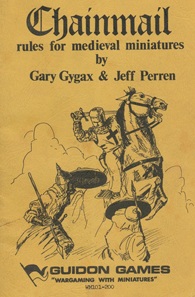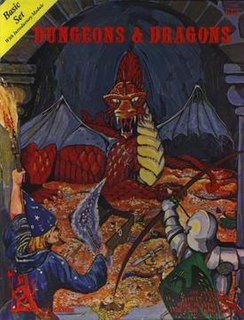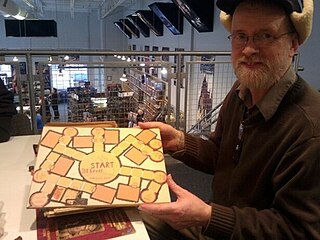
Ernest Gary Gygax was an American game designer and author best known for co-creating the pioneering role-playing game Dungeons & Dragons (D&D) with Dave Arneson.

TSR, Inc. was an American game publishing company, best known as the original publisher of Dungeons & Dragons (D&D).

David Lance Arneson was an American game designer best known for co-developing the first published role-playing game (RPG), Dungeons & Dragons, with Gary Gygax, in the early 1970s. Arneson's early work was fundamental to the development of the genre, developing the concept of the RPG using devices now considered to be archetypical, such as adventuring in "dungeons" and using a neutral judge who doubles as the voice and consciousness of all characters aside from the player characters to develop the storyline.

Miniature wargaming is a form of wargaming in which military units are represented by miniature physical models on a model battlefield. The use of physical models to represent military units is in contrast to other tabletop wargames that use abstract pieces such as counters or blocks, or computer wargames which use virtual models. The primary benefit of using models is aesthetics, though in certain wargames the size and shape of the models can have practical consequences on how the match plays out.

Blackmoor is a fantasy role-playing game campaign setting generally associated with the game Dungeons & Dragons. It originated in the early 1970s as the personal setting of Dave Arneson, the co-creator of Dungeons & Dragons, first as a setting for Arneson's miniature wargames, then as an early testing ground for what would become D&D.

Chainmail is a medieval miniature wargame created by Gary Gygax and Jeff Perren. Gygax developed the core medieval system of the game by expanding on rules authored by his fellow Lake Geneva Tactical Studies Association (LGTSA) member Perren, a hobby-shop owner with whom he had become friendly. Guidon Games released the first edition of Chainmail in 1971.
Guidon Games produced board games and rulebooks for wargaming with miniatures, and in doing so influenced Tactical Studies Rules, the publisher of Dungeons & Dragons. The Guidon Games publishing imprint was the property of Lowrys Hobbies, a mail-order business owned by Don and Julie Lowry. About a dozen titles were released under the imprint from 1971 to 1973.
David Wesely is a wargamer, board game designer, and video game developer. Wesely's developments, inspired by Kriegsspiel wargames, were important and influential in the early history of role-playing games.
The Midwest Military Simulation Association (MMSA) is a group of wargamers and military figurine collectors active during the late 1960s and 1970s.

Mike Carr is a writer and game designer.

The Castle & Crusade Society was a chapter of the International Federation of Wargaming dedicated to medieval miniature wargaming.
Don Lowry is a wargamer, businessman, illustrator, and game designer who is best known as the publisher of Chainmail and the editor of Panzerfaust Magazine.

Robert J. Kuntz is a game designer and author of role-playing game publications. He is best known for his contributions to various Dungeons & Dragons-related materials.

Naval wargaming is a branch of the wider hobby of miniature wargaming. Generally less popular than wargames set on land, naval wargaming nevertheless enjoys a degree of support around the world. Both historical and fantasy rulesets are available.
Donald R. Kaye was the co-founder of Tactical Studies Rules (TSR), the game publishing company best known for their Dungeons & Dragons (D&D) role-playing game. He and TSR co-founder Gary Gygax had been friends since childhood, sharing an interest in miniature war games. In 1972, Kaye created Murlynd, one of the first D&D characters, and play-tested him in Gygax's Castle Greyhawk campaign. Kaye and Gygax were convinced that D&D and similar games were an excellent business opportunity, and together they founded Tactical Studies Rules in 1973. However, only two years later, just as sales of D&D started to rise, Kaye unexpectedly died of a heart attack at age 36.

Greyhawk is a supplementary rulebook written by Gary Gygax and Robert J. Kuntz for the original edition of the Dungeons & Dragons (D&D) fantasy role-playing game. It has been called "the first and most important supplement" to the original D&D rules. Although the name of the book was taken from the home campaign supervised by Gygax and Kuntz based on Gygax's imagined Castle Greyhawk and the lands surrounding it, Greyhawk did not give any details of the castle or the campaign world; instead, it explained the rules that Gygax and Kuntz used in their home campaign, and introduced a number of character classes, spells, concepts and monsters used in all subsequent editions of D&D.

The Dungeons & Dragons Basic Set is a set of rulebooks for the Dungeons & Dragons (D&D) fantasy role-playing game. First published in 1977, it saw a handful of revisions and reprintings. The first edition was written by J. Eric Holmes based on Gary Gygax and Dave Arneson's original work. Later editions were edited by Tom Moldvay, Frank Mentzer, Troy Denning, and Doug Stewart.
Brian John Blume was an American game designer and writer, principally known as a former business partner of Gary Gygax at TSR, Inc., original publishers of the fantasy role-playing game Dungeons & Dragons.
Jon Pickens is an American game designer and editor who has worked on numerous products for the Dungeons & Dragons fantasy role-playing game from TSR and later Wizards of the Coast.

David R. Megarry is a game designer most notable for the board game Dungeon!.














